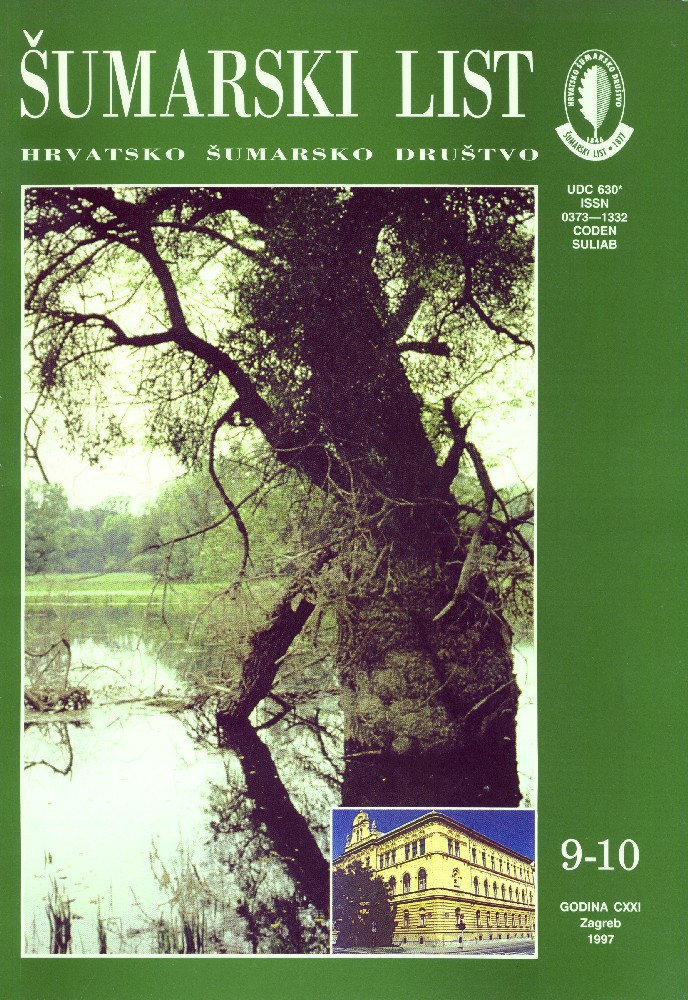
broj: 9-10/1997
pdf (24,8 MB) |
|
||||||||||||||
| IZVORNI ZNANSTVENI ČLANCI | ||
| Matić, S., Anić, I., Oršanić, M. | UDK 630* 233 + 913.001 | |
| Afforestation, Tending and Regeneration as the Basic Prerequisite for Ecological, Social and Economic Development of the Mediterranean pdf HR EN | 463 | |
| Čavlović, J., Marović, T. | UDK 630* 569 (001) | |
| Relations of Fir Tree Increment in the Educational-experimental Forest Facility "Sljeme" pdf HR EN | 473 | |
| Summary: Since fir, in combination with beech and spruce, forms very valuable selection forests (8 % of the entire forested area in Croatia), a change in the structure of selection stands at the expense of fir is a worrying occurrence. The change is reflected in a lessened fir participation in the species constitution, the absence of natural regeneration, and the disruption of a normal selection structure. Significant differences were noted in the structure of selection stands growing below and above the altitude of 700 m in the Faculty forest of Sljeme. The aim was to determine how the differences in the constitution of fir selection stands were reflected on the relations of fir increment between the two mentioned groups of stands. Based on the measurements conducted in the stands at lower positions (below 700 m), and in those at higher positions (above 700 m), the following was observed: In terms of species constitution, regularity of selection structure, and state of regeneration, stands at lower positions provide much better conditions for the growth and development of fir trees. The average time of passage of fir tree for the forest as a whole in stands at lower positions is 11 years, and in those at higher positions it is 18 years. A more pronounced dependence of diameter increment on breast diameter occurred when diameter increment was equalized by using parabolas of the second order rather than the line in both observed cases. The diameter increments of medium-thick trees were noted to be especially different in the two groups of studied stands. The annual volume current increment for fir in stands above 700 m altitude is 2.17 mi/ha, while in those under 700 m altitude it is 5.68 mi/ha. The data on the time of transition, and the diameter and volume increment, generally show that the less favourable structure of higher-positioned selection stands for the fir, compared to those at lower positions, is reflected in the distinctly poorer increment of fir trees in both absolute and relative amounts. | ||
| Štefančić, A. | UDK 630* 325 + 859 (001) | |
| The Proportion of Wood Assortments in the up-to-7-cm-diameter Stemwood Volume of the Pedunculate Oak, Sessile-flowered Oak and Field Ash - dry type pdf HR EN | 479 | |
| Hitrec, V. | UDK 519.24 + 630* | |
| Application of Stochastics to Scientific Research, Problems - Misconceptins - Risks pdf HR EN | 499 | |
| STRUČNI ČLANCI | ||
| Rubić, G. | UDK 630* 231 + 232 : 232.31 | |
| Acorn Regeneration of the Pedunculate Oak in the Vinkovci Forest Management Area pdf HR EN | 507 | |
| Tomašević, A. | UDK 630* 919 + 630* 11 +233 | |
| History of Afforestation on the Island of Vis pdf HR EN | 515 | |
| Gračan, J. | UDK 630* 231 | |
| The Hemeroby of Austrian Forest Ecosystems pdf HR EN | 527 | |
| Frković, A. | UDK 630* 159 | |
| Sixty Years of the Temporary CIC Formula for Evaluation of Deer Antlers pdf HR EN | 533 | |


